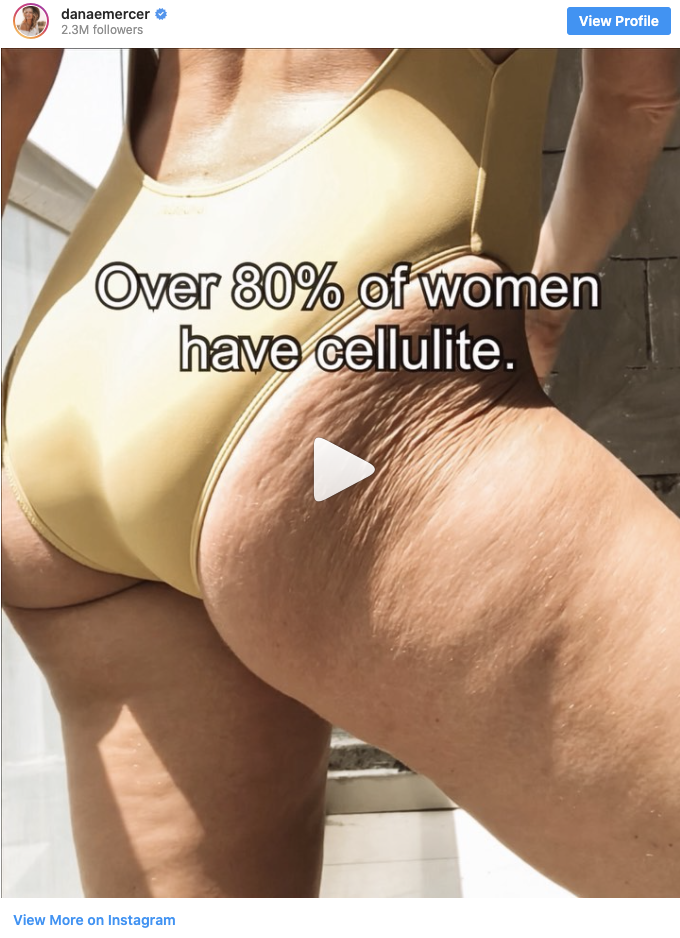How it works:
Share your skin goals and snap selfies
Your dermatology provider prescribes your formula
Apply nightly for happy, healthy skin
How it works:
How it works:
Share your skin goals and snap selfies
Your dermatology provider prescribes your formula
Apply nightly for happy, healthy skin
How it works:
Almost everyone has cellulite, and that’s okay
Why it’s totally normal and why you can’t just scrub it off.



In this article
In a world obsessed with smooth skin and thinness, normalizing cellulite is easier said than done. If these dimples don’t make you feel cute, that’s totally understandable. That said? Not only is your cellulite totally harmless, but almost everyone has it. In fact, between 80–90% of adult women¹ may have some form of cellulite. It can start appearing as early as puberty, and it can happen to bodies of all sizes. In other words, your cellulite isn’t an indicator of your overall health!
So… what is cellulite, anyway?
To put it simply, cellulite is the appearance of bumpy, dimpled skin on fleshy parts of the body. Cellulite is naturally caused by the way our skin connects to fat and muscle. Skin is tethered to the muscle beneath by rope-like fibers that stretch through a middle layer of fat. As fat builds up, it pushes upwards against the skin, and the fibers pull down. This sometimes creates dimples in the skin, a.k.a. cellulite.²
Cellulite tends to be most noticeable on the parts of our body that store fat. For most women, that’s their thighs, hips, butt, and abdomen. Cellulite isn’t always visible, either. Try pinching a fleshy part of your body where the skin looks smooth. You’ll probably notice that, when squeezed, the skin looks wavy or bumpy. That’s cellulite, whether you see it all the time or not.
Fact: cellulite isn’t bad.
One body positive mantra we can get behind: weight is not an indicator of health. Likewise, your cellulite isn’t an indicator of health. Yes, cellulite tends to be more noticeable in people with more body fat.³ But cellulite can (and does) appear on bodies of all sizes.

If you want to prevent or treat cellulite, you might consider weight loss as one approach. Please know, though, that cellulite is much more complicated than that, and body fat isn’t the only factor. Hormones and genetics also play a role.³ Additionally, cellulite is caused by a breakdown in collagen,¹ which occurs naturally in most bodies over time. Eating healthy and working out can definitely boost your health, inside and out. But embracing your cellulite might be easier than trying to get rid of it.
Cellulite scrubs? We don’t buy it.
From Hollywood celebrities to Instagram influencers, mass media promotes unrealistic standards of beauty. Completely smooth, poreless skin is usually the result of Facetune or Photoshop rather than the right combination of skincare products — these ideals are simply unattainable.
Some skincare products like creams and scrubs claim to reduce or even completely get rid of cellulite over time. But, truth be told, there isn’t much medical proof that these products do anything. Because of the way topical caffeine temporarily constricts blood vessels, coffee scrubs might temporarily improve the appearance of cellulite. In-office procedures like laser therapy (while sometimes effective in the short term) do not necessarily have long-lasting results, and further study is still needed.
Basically, when it comes to cellulite treatments, we think you’d be better off saving your money. While accepting your cellulite might not happen overnight, you can still be empowered by not letting brands exploit your insecurities for profit.
You are enough.
If accepting our bodies was as easy as listening to Lizzo on repeat, our collective insecurities would have been left in 2019. But no matter how much body positivity you welcome into your life, body acceptance isn’t something you can just check off a to-do list. Instead, it’s a lifelong journey. It’s okay if you don’t feel good about your cellulite today — you can still acknowledge that your skin’s appearance doesn’t determine your worth. Self-love is never one-size-fits-all. Give your conflicting feelings space to co-exist. Be kind to yourself. And remember: you’re not alone 💜
P.S.
We did the research so you don’t have to, but if you’d like to do some additional reading on cellulite, feel free to check out our sources:
From “Treatment for cellulite,” by Neil Sadick, 2018. International Journal of Women’s Dermatology, 5(1), pp. 68–72. (https://pubmed.ncbi.nlm.nih.gov/30809581/)
Mayo Clinic. “Cellulite,” 2019. Mayo Clinic Health Library. (https://www.nchmd.org/education/mayo-health-library/details/CON-20212580)
From “Cellulite,” by Sharon Wai Cheng Fong, 2010. DermNet NZ. (https://dermnetnz.org/topics/cellulite/)
Curology and our dermatology providers do not treat cellulite and our products are not intended for that use. We’re here to share what we know — but don’t take it as medical advice. Please talk to your medical provider if you have questions.

Curology Team